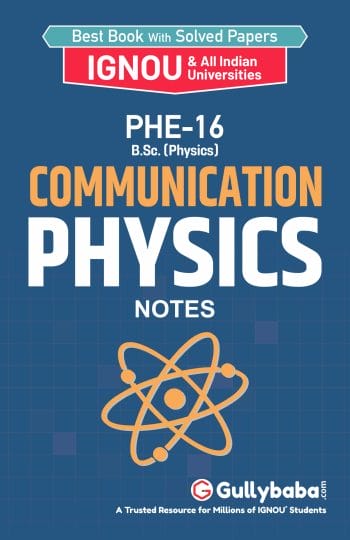IGNOU PHE-16 (January 2024 - December 2024) Assignment Questions
1. State with reasons whether the following statements are True or False.
i) The best mode for transmitting optical signal is Line-of-Sight communication.
ii) A simple sine wave signal does not carry any information.
iii) Input impedance for an open ended transmission line of λ/2 length is zero.
iv) Amplitude distortion in AM gives rise to unwanted frequency components.
v) Amplitude shift keying is modulation of digital carrier by analog signal.
vi) Mobile telephony uses time division multiplexing.
vii) Gunn devices can be built using indirect band gap semiconductors.
viii) In television, vertical scanning frequency is higher than horizontal scanning frequency.
ix) Machine language programmes are portable, while assembly language programmes are not.
x) Router can provide inter-conversion of protocols among connections.
2. a) What are the characteristics of the first stage amplifier of an audio receiver circuit?
b) Explain the use of step input signal in characterizing a communication system. Why square wave signal is preferred over step input signal?
3. a) For a conductor, number of collisions per second is 1012, and plasma frequency is ωp = 2π × 10 15. Calculate the skin depth for the signal frequency of (i) 50 Hz, and (ii) 50 MHz.
b) You have an open ended line of 3λ/4 length. Draw the incident, reflected and resultant voltage and current waves for the current maximum at generator end.
4. a) 10 kHz audio signal is amplitude modulated over a 100 kHz carrier frequency. The peak amplitude of carrier wave is 10 V. If the modulation index is 0.8, find out the frequencies present in the modulated output. Also calculate the maximum and the minimum amplitude of the envelope of modulated signal.
b) Depict digital signal 101101001 in (i) unipolar RZ, (ii) bipolar NRZ, (iii) bipolar RZ, and (iv) Manchester code.
5. a) Explain the time division switching used in telephony.
b) Design a TDM system to handle 3 PAM channels if the maximum input frequency of each channel is 50 kHz.
6. a) What are the functions of synchronizing circuits in a television receiver? How are these functions accomplished by using a sync separator circuit?
b) Discuss the advantages of FM over AM in radio transmission. What are the essential differences between AM and FM receiver circuits?
7. a) With the help of appropriate diagram, explain the difference between E-plane and H-plane T-structures of the waveguide.
b) Compare LED and laser diode used as sources in optical fibre communication.
8. a) Explain the process of instruction execution in a van Neumann machine.
b) Explain the different types of client-server network architecture.
9. a) What is the difference between Internet and intranet? What are the advantages of intranet?
b) What is blue tooth technology? What are the concerns regarding the interference among blue tooth connections? How are they resolved?
IGNOU PHE-16 (January 2023 - December 2023) Assignment Questions
1. State with reasons whether the following statements are True or False.
i) Rise time of a pulse is the time required for the amplitude to reach from 0% to 100% of the peak amplitude value.
ii) Standing wave ratio of a matched transmission line is zero.
iii) Amplitude modulation index for dc modulating signal is 100%.
iv) Skin depth increases with frequency.
v) Though audio frequency range is 20 Hz to 20 kHz, the telephone uses only 4 kHz bandwidth per channel, still the communication is audible.
vi) In superheterodyne receiver the local oscillator always operates at a fixed frequency.
vii) CCD camera requires electron gun for scanning.
viii) In satellite communication, the higher frequency range is chosen for up-linking.
ix) Token ring protocol suffers with the data collision problem.
x) Blue tooth works only for mobile devices.
2. a) What approach is followed in practice for the choice of a propagation medium for any communication system? Why is a linear medium of propagation preferred?
b) Explain the procedure of stub matching in transmission lines.
3. a) Calculate the noise power and noise voltage generated by a 1MΩ resistor at 37°C over a 1 MHz bandwidth.
b) A dipole antenna of dl = 2m carries 20 A peak current at 200 MHz frequency. Calculate the radiation intensity in the side-on direction at a distance of 10 km.
4. a) Explain the working of balance modulator for AM generation. State its advantages over a transformer coupled class-C amplifier based AM generator.
b) Explain, how digital coding can help in overcoming the burst error noise in signal transmission.
5. a) State the various techniques used for analog modulation of a digital signal carrier. How are they used for continuous wave transmission and two tone modulation systems? State the advantages of two tone modulation system.
b) In mobile telephony explain in detail the functions of base station and mobile switching centre.
6. a) Explain the image frequency and double spotting phenomena in case of AM receivers. How can they be overcome?
b) What is the role of blanking and sync pulses in a TV signal? How are these pulses incorporated with the video signal?
7. a) Explain the construction of a Schottky diode and state its advantages over normal p-n junction diode.
b) With an appropriate diagram, explain the construction of graded index multimode fibre. How does it reduce the modal dispersion?
8. a) Write down the instructions involved in adding three numbers X, Y, Z and storing the result in memory location D.
b) Differentiate between a Router and a Gateway.
9. a) Justify the need of standard network protocols and describe the various layers of OSI model.
b) Explain the WAE layer of WAP architecture. Write any four uses of WAP.
Buy PHE-16 Assignment 